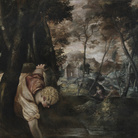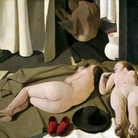Henriette Fortuny. Portrait of a muse

© Fondazione Musei Civici di Venezia - Archivio Museo Fortuny | Mariano Fortuny, Henriette a Parigi, 1902. Lastra di vetro alla gelatina, 120 x 90 mm
From 19 Dicembre 2015 to 01 Maggio 2016
Venice
Place: Museo di Palazzo Fortuny
Address: San Marco - San Beneto
Times: 10am-06pm; closed on Tuesday
Responsibles: Daniela Ferretti, Cristina Da Roit
Prolungata: la mostra è stata prorogata
Ticket price: full € 12, reduced and groups € 10, schools € 5
Telefono per informazioni: 848082000
E-Mail info: info@fmcvenezia.it
Official site: http://www.fortuny.visitmuve.it
This exhibition is a tribute to a woman who, by her intelligence and sensitivity, succeeded in supporting and inspiring one of the most refined artists of the past century. Adèle Henriette Nigrin was born in Fontainebleau in 1877, and in met Mariano Fortuny in Paris at the start of the 20th century.
Fortuny was already a well-known artist, involved in experimenting with a complex system of lighting that from its early application would revolutionise stage lighting in the theatre.
The meagre biographical notes tell us little more, but what is clear is that from 1902 and for no less than 47 years, Henriette would be at Fortuny’s side, contributing in a decisive manner to the success of his splendid textile creations.
She it was, for instance, who was responsible for the idea of the Delphos, the fine plissé silk gown that became a worldwide icon of style and the symbol of a timeless elegance. In the house and workshop of Palazzo Pesaro degli Orfei, Henriette worked alongside her husband in the creation of fine printed fabrics and silk lampshades, coordinating the work of the craftsmen they employed. It was she who maintained the delicate relations with an increasingly numerous and international clientele, leaving Fortuny to dedicate himself to his studies, research and experiments in various artistic disciplines.
After the death of her husband (1949) and the sale of the Società Anonima Fortuny to her friend, Elsie McNeill, Henriette dedicated the rest of her life to fulfilling Mariano’s testamentary wishes – donating numerous works to Italian and Spanish museums – and to creating an inventory of the works of art in the palazzo, which upon her death was bequeathed to the city of Venice.
Curated by Daniela Ferretti and Cristina Da Roit, the exhibition is the result of the research, re-ordering and maintenance undertaken during the course of 2015 in the collections of Museo Fortuny, which has made it possible to select 200 photographs from the Fortuny photographic archive, choosing from a corpus of over 12,000 original gelatine glass plates and celluloid films. These have been submitted to a major operation of conservation and archiving, which also saw the re-ordering and digitalisation of the collection of blocks for printing fabrics.
The exhibition will also offer the first ever opportunity for the public to view some amateur films made by Mariano in the 1930s. These films have been found only recently and consist of film in pathé baby format and 35 mm film. Thanks to the support of Maison Vuitton, these have been restored and digitalised by the Archivio Nazionale Cinema Impresa of Ivrea and the La Camera Ottica and Crea laboratories of the Università degli Studi di Udine. Catalogue published by the Fondazione Musei Civici di Venezia, edited by Daniela Ferretti, with texts by Daniela Ferretti, Claudio Franzini and Cristina Da Roit.
Fortuny was already a well-known artist, involved in experimenting with a complex system of lighting that from its early application would revolutionise stage lighting in the theatre.
The meagre biographical notes tell us little more, but what is clear is that from 1902 and for no less than 47 years, Henriette would be at Fortuny’s side, contributing in a decisive manner to the success of his splendid textile creations.
She it was, for instance, who was responsible for the idea of the Delphos, the fine plissé silk gown that became a worldwide icon of style and the symbol of a timeless elegance. In the house and workshop of Palazzo Pesaro degli Orfei, Henriette worked alongside her husband in the creation of fine printed fabrics and silk lampshades, coordinating the work of the craftsmen they employed. It was she who maintained the delicate relations with an increasingly numerous and international clientele, leaving Fortuny to dedicate himself to his studies, research and experiments in various artistic disciplines.
After the death of her husband (1949) and the sale of the Società Anonima Fortuny to her friend, Elsie McNeill, Henriette dedicated the rest of her life to fulfilling Mariano’s testamentary wishes – donating numerous works to Italian and Spanish museums – and to creating an inventory of the works of art in the palazzo, which upon her death was bequeathed to the city of Venice.
Curated by Daniela Ferretti and Cristina Da Roit, the exhibition is the result of the research, re-ordering and maintenance undertaken during the course of 2015 in the collections of Museo Fortuny, which has made it possible to select 200 photographs from the Fortuny photographic archive, choosing from a corpus of over 12,000 original gelatine glass plates and celluloid films. These have been submitted to a major operation of conservation and archiving, which also saw the re-ordering and digitalisation of the collection of blocks for printing fabrics.
The exhibition will also offer the first ever opportunity for the public to view some amateur films made by Mariano in the 1930s. These films have been found only recently and consist of film in pathé baby format and 35 mm film. Thanks to the support of Maison Vuitton, these have been restored and digitalised by the Archivio Nazionale Cinema Impresa of Ivrea and the La Camera Ottica and Crea laboratories of the Università degli Studi di Udine. Catalogue published by the Fondazione Musei Civici di Venezia, edited by Daniela Ferretti, with texts by Daniela Ferretti, Claudio Franzini and Cristina Da Roit.
SCARICA IL COMUNICATO IN PDF
COMMENTI

-
 Dal 22 febbraio 2025 al 29 giugno 2025
Forlì | Museo Civico San Domenico
Dal 22 febbraio 2025 al 29 giugno 2025
Forlì | Museo Civico San Domenico
-
 Dal 21 febbraio 2025 al 29 giugno 2025
Rovigo | Palazzo Roverella
Dal 21 febbraio 2025 al 29 giugno 2025
Rovigo | Palazzo Roverella
-
 Dal 21 febbraio 2025 al 27 aprile 2025
Roma | Palazzo Doria Pamphilj
Dal 21 febbraio 2025 al 27 aprile 2025
Roma | Palazzo Doria Pamphilj
-
 Dal 26 febbraio 2025 al 20 luglio 2025
Bologna | Palazzo Pallavicini
Dal 26 febbraio 2025 al 20 luglio 2025
Bologna | Palazzo Pallavicini
-
 Dal 15 febbraio 2025 al 29 giugno 2025
Milano | Palazzo Reale
Dal 15 febbraio 2025 al 29 giugno 2025
Milano | Palazzo Reale
-
 Dal 14 febbraio 2025 al 14 settembre 2025
Roma | Chiostro del Bramante
Dal 14 febbraio 2025 al 14 settembre 2025
Roma | Chiostro del Bramante


